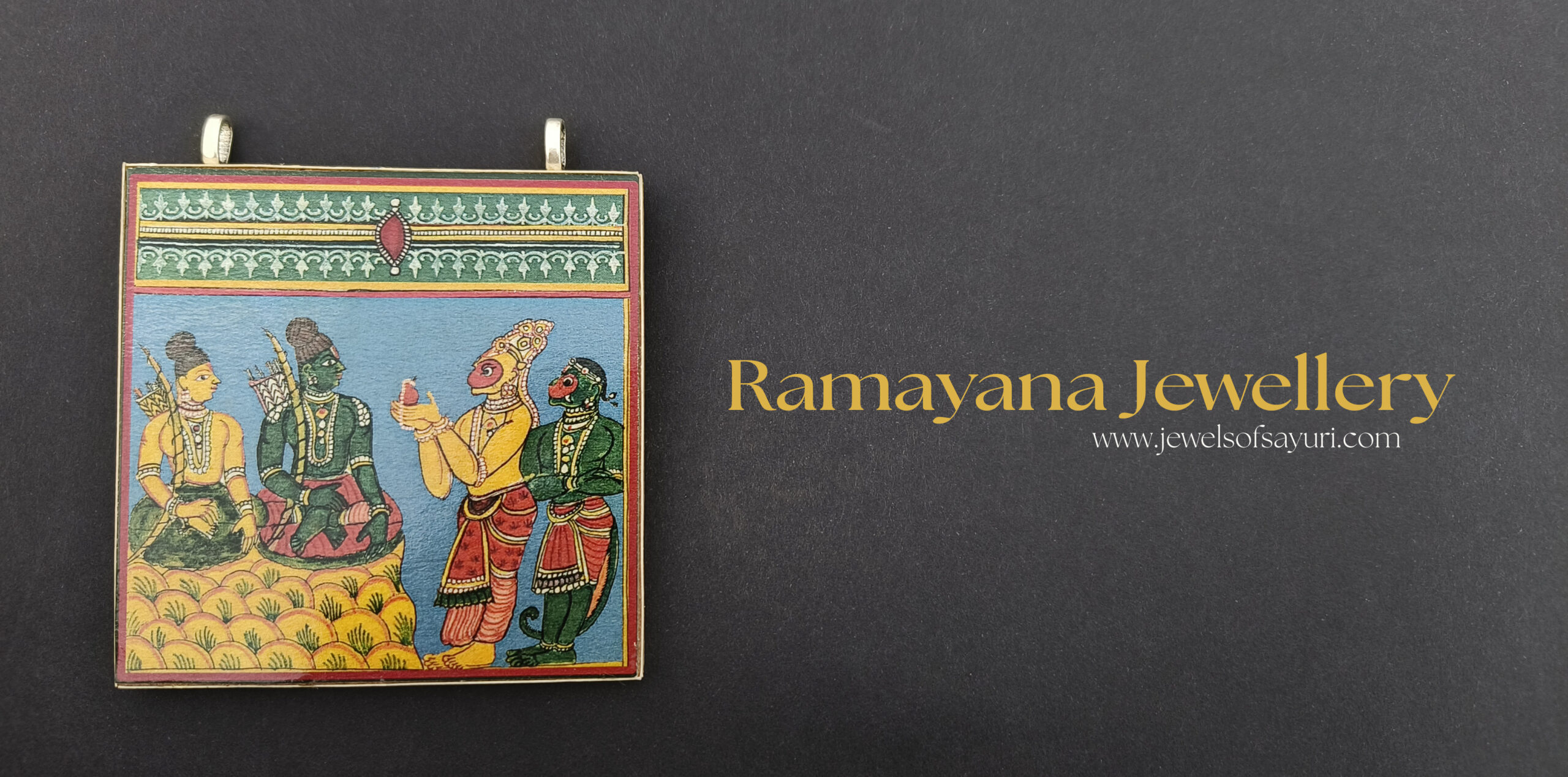As a picture jewellery maker and researcher, I am constantly on the look out of old images, themes and ideas that I could use in my work. I also search for literature to learn more about ideas of image making, visualisation and narratives. during one such search, I came across a treasure trove of old French – Tamil books including Histoire et figures des dieux des Indiens ou Théogonie des Malabariquais. I found several paintings of Hindu Gods and Goddesses, including narratives from the epic Ramayana. Since today is Ram Navami (the birth celebrations of Rama), I would like to show Ramayana Jewellery that I made based on the paintings.

History and Figures of the Gods of India, or the Theogony of the Malabaris
In the 1750s, four albums with miniature painitings and hand written text was assembled by Abraham Pierre Porcher des Oulches. He was the then commandant of places like Masulipattinam and Karaikal in Southern India. The History and Figures of the Gods of India, or the Theogony of the Malabaris’ is one of them. I am not sure what the art style draws from but the richly detailed paintings are a delight to look at. According to Donovan Roebert, the paintings in the album are considered to be proto-company or the those that inspired the Kampani Kalam paintings in colonial India.
The images are accompanied by hand written Tamil text, a little of which I am able to read. There is also some French text but it is not a readable print.

Ramayana Jewellery
Ramayana is a Hindu epic that details the life history of King Rama of Ayodhya, his brothers – Lakshmana, Bharata and Satrugana, his wife Sita, the princess of Janakpuri. Rama is considered as a form of Lord Vishnu and Sita, a form of Bhudevi, a daughter of Mother Earth. Rama, Lakshmana and Sita live in exile for 14 years. During this time, Sita is kidnapped by Ravana, the king of Lanka. Jewellery places a very important role in her identification.
I have worked with several Rama and Sita images before this in my Chithiram, Chitra Katha and Sanmoh collection using single existing images. I also worked on original images in the form of a continuos narrative in the same piece for my Jewelry in Narratives project. However, this is the first time that I am telling a story in three panels, not in the same necklace but with one each in three different necklaces.

A story in three panels
The first panel depicts Rama and Lakshmana meeting the Vaanaras, or a group of forest dwellers with a monkey like face. They show the brothers a collection of fallen jewels which Lakshmana identifies as belongin to Sita. You can read more about the story in my post on on Sita’s anklets in the “Jewelry in Narratives” project website. The Vaanaras tell the brothers of a woman who was kidnapped and flown southwards to probably Lanka. They decide to send a scout to look for her. That scout is Hanuman.

Rama’s signet Ring
After learning how to identify Sita from Rama, he asks for memento to impress upon Sita, that he is indeed a messenger for her husband. Rama gives Hanuman his Signet ring or Kanaiyaazhi. I have previously used the image of Hanuman in my Mixed materials jewellery set.

Choodamani Pradhanam
Hanuman sets off on his way to Lanka and crosses the Indian ocean. Several episodes of valour and wit later, he finds a forlon Sita held in Ashokavanam (grove of Ashoka trees). Sita is scared upon meeting a talking monkey but is reassured upon seeing the signet ring of Rama. She refuses to go with him. Instead she give him her Choodamani, hair jewel to present to Rama as a reminder that she is waiting for him to come rescue her. Another of my bib necklaces for “Jewelry in Naratives” discusses Chudamani Pradhanam in detail. Do check out both posts to see original artworks and alternative visualisations of the same story.
Making and Styling the necklaces
I wore the two necklace shown above to an Art exhibition – Imaginarium that I had curated. The MOP and shell pearl beads along with the bright orange pendant matched my Blue sungudi saree with an orange border and white blouse. I wore the green bead neckalce with an orange saree and an Off-white blazer while hosting an interview and disucssion with the artist. Find the opening and closing looks on my Instagram here. The first pendant waits unstrung for an ocassion.
I made the jewellery to suit my clothes at the last moment. Therefore, my choice of beads were influenced by what I had in hand. However, as the pendants are so colourful they could match with almost beads of any material and colour. I have religiously edited the paintings digitally and printed them on a golden paper. They look so pretty in real life and the paintings do not do them justice. I will post some photos/videos on Instagram.
In the meanwhile, do tell me what you think about my Ramayana jewellery in the comments.
Also, my blog has been having some issues with stats dropping like crazy. I would be much obliged if you could share posts/tutorials that you find interesting with your circle so that I can see where the problem lies. Thank you.
I hope you find it interesting
Cheers



What do you think?